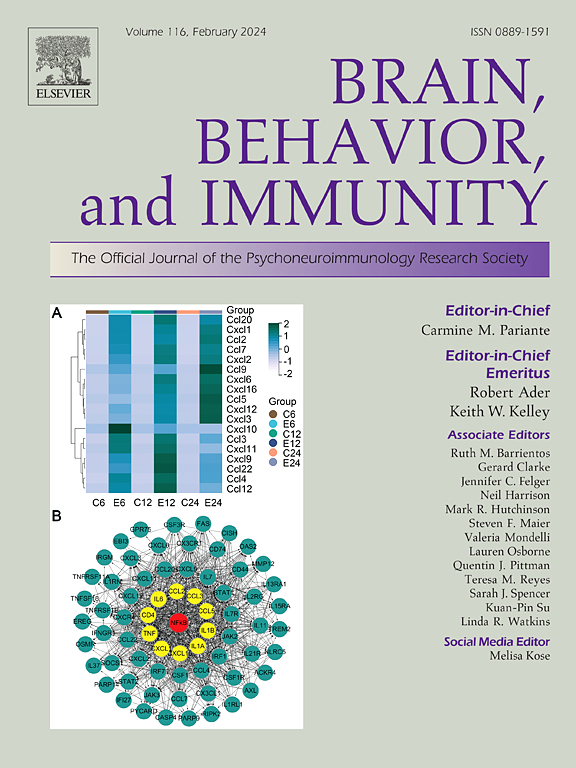孕期母体感染 COVID-19 对新生儿免疫系统的影响以及与日后诊断出神经发育障碍的关系。
IF 8.8
2区 医学
Q1 IMMUNOLOGY
引用次数: 0
摘要
尽管 COVID-19 在母体和后代健康中普遍存在并备受关注,但人们对孕期 COVID-19 对新生儿免疫和神经发育的影响却知之甚少。本研究旨在探讨:1)孕期母体 COVID-19 与新生儿免疫特征之间的关系;2)产前暴露于 COVID-19 的儿童中,特定新生儿免疫特征与随后诊断出神经发育障碍(NDD)的风险之间的关联。2020 年 1 月至 2021 年 9 月期间在北加州凯泽医疗中心(Kaiser Permanente Northern California)出生的 545 名儿童(460 名[223 名男性,237 名女性],母亲为 COVID-19 感染者[COVID+];85 名[45 名男性,40 名女性],母亲为 COVID-19 未感染者[COVID-])的新生儿干血球(NBS)被用于通过 42 复合物细胞因子/趋化因子检测分析新生儿免疫分子。在 COVID + 母亲所生的 460 名儿童中,有 73 名(47 名男性,27 名女性)后来被诊断出患有 NDD。第一组分析研究了母亲在怀孕期间感染 COVID-19 与新生儿免疫特征之间的关系,经协变因素调整但未经多重比较校正的结果显示,COVID + 母亲的新生儿 IL-22 水平显著较高(est. = 0.16, 95 % Cl 0.01, 0.3, p = 0.04)和 GM-CSF(估计值 [est.] = 0.27, 95 % Cl 0.09, 0.46, p = 0.004)水平明显高于 COVID- 母亲的新生儿。经多重比较调整后,这些差异不再具有统计学意义。第二项分析探讨了 COVID + 母亲所生新生儿特征与日后 NDD 诊断之间的关系,根据协变量调整后的结果显示,新生儿 IL-22 水平较高(HR = 0.49,95 % Cl 0.33,0.75,p = 0.001)与日后 NDD 诊断风险较低之间存在关联,经多重比较调整后,该关联仍具有显著性(p = 0.04)。其他新生儿细胞因子/凝血因子/生长因子,如 sCD40L(HR = 0.7,95 % Cl 0.57,0.9,p = 0.009)、IP-10(HR = 0.46,95 % Cl 0.25,0.83,p = 0.009)、MIG(HR = 0.52,95 % Cl 0.3,0.9,p = 0.02)、FLT-3L(HR = 0.45,95 % Cl 0.24,0.83,p = 0.01)、PDGF AB/BB(HR = 0.56,95 % Cl 0.36,0.99,p = 0.046)、VEGF(HR = 0.57,95 % Cl 0.34,0.98,p = 0.04)和 IL-4(HR = 0.48,95 % Cl 0.26,0.93,p = 0.03)经多重比较调整后不再具有统计学意义。尽管本研究队列中暴露于 COVID-19 和未暴露于 COVID-19 的新生儿数量不平衡,但我们的新发现加深了我们对孕期母体感染 COVID-19 对新生儿免疫系统发育的潜在影响的理解。我们的研究结果强调了免疫分子的作用,除了那些被认为是促炎症的分子外,这些分子可能对孕期母体和新生儿抵御 COVID-19 感染至关重要。此外,我们的研究结果表明,COVID + 母亲的新生儿免疫分子水平降低可能与随后诊断出 NDD 的风险增加有关。本文章由计算机程序翻译,如有差异,请以英文原文为准。
The association of maternal COVID-19-infection during pregnancy on the neonatal immune profile and associations with later diagnosis of neurodevelopmental disorders
Despite the prevalence and significant concern of COVID-19 in maternal and offspring health, little is known about the impact of COVID-19 during pregnancy on newborn immunity and neurodevelopment. This study aimed to examine 1) the relationship between maternal COVID-19 during pregnancy and newborn immune profiles and investigate the 2) associations between specific newborn immune profiles and the risk of subsequent diagnosis of a neurodevelopmental disorder (NDD) among children with prenatal exposure to COVID-19. Newborn dried bloodspots (NBS) from 545 children born at Kaiser Permanente Northern California between January 2020 and September 2021 (460 [223 males, 237 females] to COVID-19-infected [COVID+] mothers; 85 [45 males, 40 females] to COVID-19-uninfected [COVID-] mothers) were used to profile newborn immune molecules via a 42-plex cytokine/chemokine assay. Among the 460 children born to COVID+ mothers, 73 (47 males, 27 females) were later diagnosed with an NDD. In the first set of analyses examining the association between maternal COVID-19 infection during pregnancy and newborn immune profile, the results adjusted for covariates but uncorrected for multiple comparisons showed that newborns of COVID+ mothers had significantly higher levels of IL-22 (estimate [est.] = 0.16, 95 % Cl 0.01, 0.3, p = 0.04) and GM-CSF (est. = 0.27, 95 % Cl 0.09, 0.46, p = 0.004) compared to newborns of COVID- mothers. These differences were no longer statistically significant after multiple comparison adjustments. In the second analysis exploring the association between newborn profile and later diagnosis of NDD among newborns born to COVID+ mothers, the results adjusted for covariates revealed an association between higher neonatal levels of IL-22 (hazard ratio [HR] = 0.49, 95 % Cl 0.33, 0.75, p = 0.001) and lower risk of a later diagnosis of an NDD, which remained significant after multiple comparison adjustments (p = 0.04). Other neonatal cytokines/chemokines/growth factors such as sCD40L (HR = 0.7, 95 % Cl 0.57, 0.9, p = 0.009), IP-10 (HR = 0.46, 95 % Cl 0.25, 0.83, p = 0.009), MIG (HR = 0.52, 95 % Cl 0.3, 0.9, p = 0.02), FLT-3L (HR = 0.45, 95 % Cl 0.24, 0.83, p = 0.01), PDGF AB/BB (HR = 0.56, 95 % Cl 0.36, 0.99, p = 0.046), VEGF (HR = 0.57, 95 % Cl 0.34, 0.98, p = 0.04), and IL-4 (HR = 0.48, 95 % Cl 0.26, 0.93, p = 0.03) were no longer statistically significant after multiple comparison adjustments. Despite the imbalance between the number of COVID-19 exposed and unexposed newborns in this study cohort, our novel findings enhance our understanding of the potential impact of maternal COVID-19 infection during pregnancy on the developing neonatal immune system. Our findings highlight the role of immune molecules, beyond those considered to be pro-inflammatory, that may be crucial in maternal and newborn immunity against COVID-19 infection during pregnancy. Furthermore, our results suggest that reduced levels of neonatal immune molecules in newborns of COVID + mothers may be linked to an increased risk of a subsequent diagnosis of an NDD.
求助全文
通过发布文献求助,成功后即可免费获取论文全文。
去求助
来源期刊
CiteScore
29.60
自引率
2.00%
发文量
290
审稿时长
28 days
期刊介绍:
Established in 1987, Brain, Behavior, and Immunity proudly serves as the official journal of the Psychoneuroimmunology Research Society (PNIRS). This pioneering journal is dedicated to publishing peer-reviewed basic, experimental, and clinical studies that explore the intricate interactions among behavioral, neural, endocrine, and immune systems in both humans and animals.
As an international and interdisciplinary platform, Brain, Behavior, and Immunity focuses on original research spanning neuroscience, immunology, integrative physiology, behavioral biology, psychiatry, psychology, and clinical medicine. The journal is inclusive of research conducted at various levels, including molecular, cellular, social, and whole organism perspectives. With a commitment to efficiency, the journal facilitates online submission and review, ensuring timely publication of experimental results. Manuscripts typically undergo peer review and are returned to authors within 30 days of submission. It's worth noting that Brain, Behavior, and Immunity, published eight times a year, does not impose submission fees or page charges, fostering an open and accessible platform for scientific discourse.

 求助内容:
求助内容: 应助结果提醒方式:
应助结果提醒方式:


